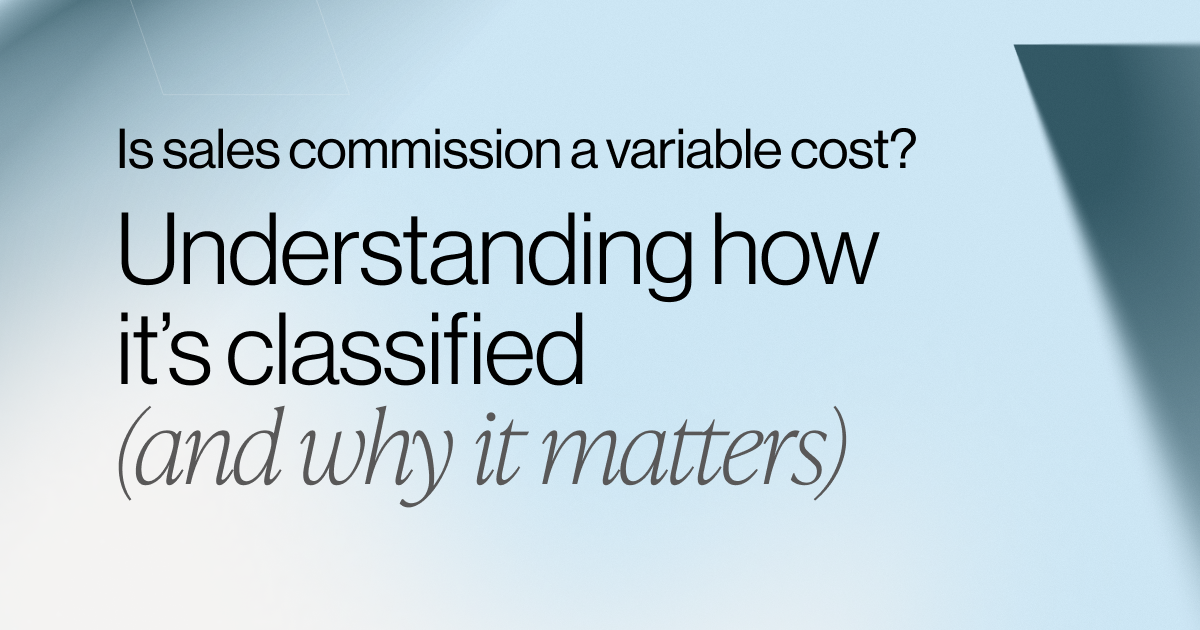8 Sales Commission Structures With Formulas + Examples [2025]
The right commission structure is key to building a strong sales team. Commission payments are a powerful incentive for your sales professionals, rewarding them for their valuable contributions to your organization.
There are many different types of commission structures to choose from. Ultimately, you’ll need to determine which one works best for your team. The right approach will depend on factors like your industry, product, and budget.
Let’s take a look at eight different sales commission structures and their benefits to determine which one is right for your organization.
What Is A Sales Commission Structure?
Along with (or at times in place of) a base salary, sales commissions make up a variable amount paid to sales teams based on a percentage or total sales. They're a standard and powerful aspect of any sales incentive compensation plan.
Businesses across industries implement sales commission structures to determine how and when to pay sales reps according to standard rules, regulations and qualifications.
{{multiplier-cta}}
Along with on-target earnings (OTE), the sales commission structure outlines how much a seller should expect to earn according to various goals and benchmarks.
Sales leaders develop and evolve compensation structures to retain and motivate top performers to accomplish critical goals.
Average commission rates will vary by industry, and will be impacted by the type of commission structure you implement.
Sales Commission Structure Examples
The most common types of sales commission structures are:
- Base Salary + Commission
- Commission Only
- Tiered Commission
- Draw Against Commission
- Territory Volume Commission
- Residual Commission
- Gross Margin Commission
- Multiplier Commission
Let's break down each type of sales commission structure and its benefits.
1. Base Salary + Commission
In this commission structure, each salesperson receives a base salary for their work in addition to commission for each sale.
For example: A salesperson might receive a $50,000 yearly salary as well as a 10% commission rate on their sales. If the salesperson made $200,000 in sales throughout the year, that would bring their total annual salary to $70,000, as they would receive $20,000 in annual commissions.
This is one of the most common commission structures out there, and for good reason. It works well for many different types of organizations, as you can tailor the base salaries and commission rates to suit your current budget.
Benefits Of This Sales Commission Structure
Many sales teams prefer this structure because they receive a guaranteed income.
This also means that your sales professionals won’t lose their entire income to factors outside of their control, such as a recession. A staggering 72% of sales professionals didn’t expect to hit their quota in 2023, so having a base salary can help prevent these concerns from affecting productivity.
This financial security can help with employee retention and job satisfaction.
In most cases, the base salary in this structure is slightly lower than it would be for employees who aren’t receiving commission. Base pay can be hourly or salaried, depending on what makes the most sense for your operations.
2. Commission Only
In a commission-only sales structure, an employee works entirely on commission with no base salary. This approach is particularly common in industries with high-value sales, such as the real estate and automotive industries.
Commission rates in this structure tend to be higher than they would be for an employee who also receives base pay. This is because the commission makes up the salesperson’s entire income.
For example: The average commission rate for auto salesmen is 20 to 30%, which allows them to live comfortably without a base salary.
Benefits Of This Sales Commission Structure
There are pros and cons to this commission structure. Some salespeople find it very stressful, as there’s no financial security when sales are slow. As a result, commission-only structures are most common for independent contractors, as they can take on more work to fill in the gaps when things are slow.
A commission-only structure also has financial benefits for your organization as a whole. This is because you’re only spending money on commissions when your sales team is drawing in revenue, so paying commissions is directly tied to financial success.
3. Tiered Commission
With a tiered commission structure, salespeople earn a higher commission rate as they sell more. This commission structure is often used to motivate reps to continue making sales even after they’ve met their initial sales quota.
This approach also benefits the company financially, as you’re only paying larger commission rates when you’re bringing in enough revenue to pay for them.
For example: Here’s what a tiered commission structure might look like:
Some companies also implement a first tier with no commission. This approach requires sales reps to meet their quota before they receive any commission.
Benefits Of This Sales Commission Structure
With a tiered commission structure, sales reps can boost their income significantly just by making a few extra sales each year. That makes this an excellent structure to use if you want to encourage your top performers to branch out and try new sales strategies.
4. Draw Against Commission
In a draw against commission structure, your salespeople are paid entirely in commissions and have a guaranteed payment amount each month. If a sales rep fails to make this guaranteed amount in commissions, they will receive it as an advance. They will then need to pay back that advance using commissions from future months.
For example: If a salesperson makes $2,000 in commissions for the month but has a guaranteed payment of $3,000, they will still receive $3,000. However, they will need to pay back the $1,000 advance at a later date when they start earning extra commissions.
Benefits Of This Sales Commission Structure
Many organizations use this approach specifically for new hires. This is because it can take time for new sales reps to reach their full earning potential. The average salesperson takes 3.2 months to ramp, and even then, there’s still room for growth and improvement. A draw against commission structure ensures that reps have some financial stability while they are learning the ropes.
However, a draw against commission structure also comes with some challenges. While sales reps will benefit from financial stability in the short term, having to pay back an advance can create extra pressure and stress in the long term. Additionally, it can be difficult to keep track of exactly what each team member owes.
5. Territory Volume Commission
In a territory volume commission structure, salespeople are assigned to a specific geographic location, such as a state, region, or country. They work with a team in that location to make sales and earn commission. That commission is then split among the entire team.
For example: Say a team of three sales representatives has a territory commission of 10%. Rep A sells $20,000 worth of product, Rep B sells $40,000, and Rep C sells $30,000, totaling $90,000. In this case, the team would receive a total commission of $9,000, which means that each rep would receive $3,000 in commission.
Benefits Of This Sales Commission Structure
Implementing this commission structure is an excellent way to encourage your sales team to work collaboratively. Team members are motivated not only to earn more money for themselves but also to support their team members. However, this can inadvertently penalize your most successful team members while also allowing underperforming team members to remain stagnant.
6. Residual Commission
A residual commission structure ensures that your team receives credit for sales they contributed to on an ongoing basis.
For example: When a salesperson closes a monthly subscription deal, they might receive 5% of that client’s monthly payments as commission rather than just making commission on the initial sale.
Benefits Of This Sales Commission Structure
This approach is common in organizations that tend to maintain an ongoing relationship with their clients. They might offer products with a subscription model or just tend to attract repeat customers. A residual commission structure also encourages your sales reps to build strong relationships with clients to maximize ongoing sales.
7. Gross Margin Commission
In this commission structure, commission percentages are calculated based on the total profit each sale generates, rather than the sale amount. With this structure, expenses are factored into the total commission amount.
For example: Say each sales rep receives a 5% gross margin commission. They sell a $10,000 product, but that sale comes with $2,000 in expenses. This makes the gross margin $8,000 and would give the salesperson a commission of $400 for that sale.
Benefits Of This Sales Commission Structure
A gross margin commission structure is financially beneficial for your organization because your expenses affect the total commission amount. If your products come with a high price tag, but also come with a large volume of associated expenses, this approach ensures that you’re not paying outsized commissions you can’t afford. It also discourages your sales reps from giving out discounts that could hurt your bottom line.
8. Multiplier Commission
In a multiplier commission structure, each sales rep starts by earning a standard percentage of each sale as commission. That percentage is then multiplied based on a variety of factors to create a custom percentage model.
For example: A rep might have a standard 10% commission that is multiplied by 0.8% if they fail to meet a quota, or is multiplied by 1.5% if they double their quota.
Benefits Of This Sales Commission Structure
If other standard sales compensation structures don’t quite fit your needs, consider using a multiplier commission structure instead. While this approach is more complex than other commission structures, it also allows you to customize your commission payments based on the factors that are most important to you.
The advantage of a multiplier commission structure is that you can adjust it based on your organization’s needs and preferences. However, multiplier commission structures can also be very difficult to keep track of and can even cause confusion among your sales staff.
Build Your Commission Structure With CaptivateIQ
Commission structures aren’t one-size-fits-all. To find the right commission structure for your organization, think about your financial goals and how you want to incentivize your sales team.
No matter which commission structure you choose, CaptivateIQ can help you implement it successfully.
CaptivateIQ’s SmartGrid technology helps you calculate commissions with ease, while detailed analytics tools give your entire sales team insight into their performance to help prevent errors.
Book a demo today to see how CaptivateIQ can streamline your commission structure.
Sales Commission Structures Frequently Asked Questions (FAQs)
What is the Best Commission Structure for Sales?
The best commission structure depends on your business model, sales cycle, and team goals — but a popular choice is the tiered commission structure. It rewards reps with higher commission rates as they exceed quota, which helps drive overperformance. For high-velocity teams, a flat-rate structure might make more sense for simplicity. For longer enterprise sales cycles, draw against commission can provide more consistent cash flow early on.
How to Structure a Sales Commission Plan?
To structure a sales commission plan effectively, identify your core objectives — are you driving net-new revenue, renewals, or upsells? Then define your components:
- Base pay vs. variable pay
- Quota targets
- Commission rate or structure (e.g., flat, tiered, or draw)
- Payout frequency and timing
- Incentives like bonuses or SPIFFs
Each element should align with your sales strategy and be easy for reps to understand. Complexity without clarity can kill motivation.
What are the Three Types of Commissions?
Three common types of sales commissions include:
- Straight commission: Reps earn a percentage of every sale without no base salary. Best for independent agents or transactional sales.
- Base salary+ Commission: A mix of fixed salary and variable pay. This is the most common structure for B2B sales teams.
- Draw against commission: Reps receive an advance (or “draw”) that’s deducted from future commissions. Helpful for ramping new hires or managing long sales cycles.
What is the Formula for Sales Commission?
AThe formula for sales commission is: Commission = Sales Amount × Commission Rate
For example, if a rep closes $80,000 in revenue at a 6% rate, their commission is $4,800. More advanced plans may factor in:
- Tiered thresholds (higher rates after hitting quota)
- Accelerators (bonus rates for exceeding goals)
- Caps or floors (minimums or maximums)
.svg)


.png)





